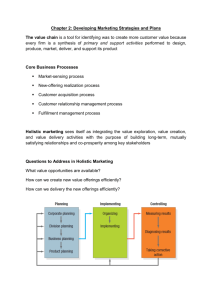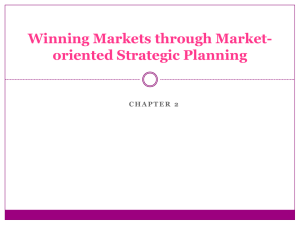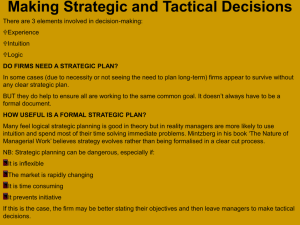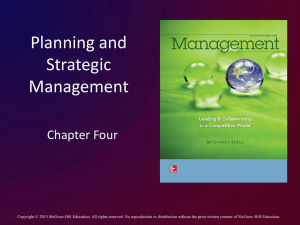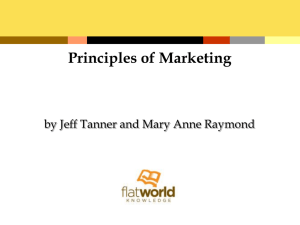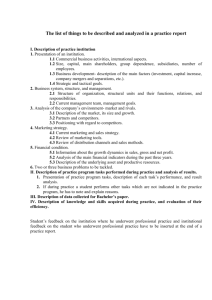Lecture7
advertisement
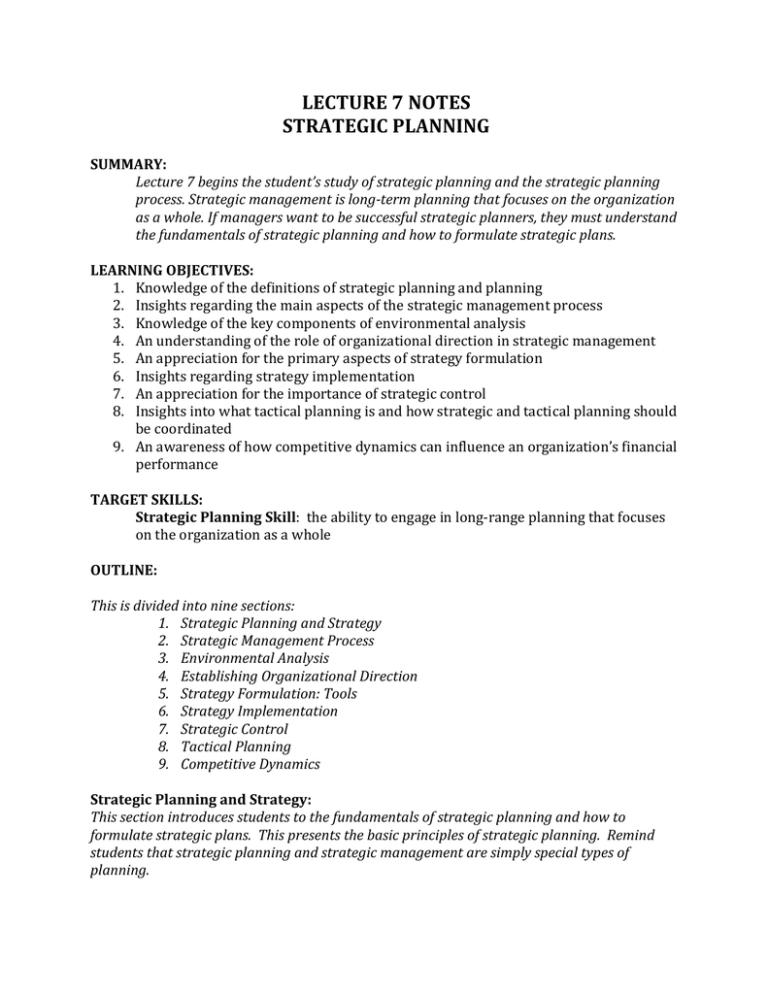
LECTURE 7 NOTES STRATEGIC PLANNING SUMMARY: Lecture 7 begins the student’s study of strategic planning and the strategic planning process. Strategic management is long-term planning that focuses on the organization as a whole. If managers want to be successful strategic planners, they must understand the fundamentals of strategic planning and how to formulate strategic plans. LEARNING OBJECTIVES: 1. Knowledge of the definitions of strategic planning and planning 2. Insights regarding the main aspects of the strategic management process 3. Knowledge of the key components of environmental analysis 4. An understanding of the role of organizational direction in strategic management 5. An appreciation for the primary aspects of strategy formulation 6. Insights regarding strategy implementation 7. An appreciation for the importance of strategic control 8. Insights into what tactical planning is and how strategic and tactical planning should be coordinated 9. An awareness of how competitive dynamics can influence an organization’s financial performance TARGET SKILLS: Strategic Planning Skill: the ability to engage in long-range planning that focuses on the organization as a whole OUTLINE: This is divided into nine sections: 1. Strategic Planning and Strategy 2. Strategic Management Process 3. Environmental Analysis 4. Establishing Organizational Direction 5. Strategy Formulation: Tools 6. Strategy Implementation 7. Strategic Control 8. Tactical Planning 9. Competitive Dynamics Strategic Planning and Strategy: This section introduces students to the fundamentals of strategic planning and how to formulate strategic plans. This presents the basic principles of strategic planning. Remind students that strategic planning and strategic management are simply special types of planning. Strategic planning o Long-range planning focusing on the organization as a whole o Management’s focus is on the organization’s strategic goal and determining what must be done to attain organization’s goals over the long term. Long-range/long-term in strategic planning is defined in terms of 3-5 years into the future Strategic planning is determining what the organization should do to be successful 35 years from now Commitment principle o Managers should commit funds for planning only if they can anticipate a return on planning expenses as a result of their long-range planning analysis Strategy o A broad and general plan developed to reach long-term objectives o Focuses on many different organizational areas – marketing, finance, production, etc. o Offers broad direction to the organization o The end result of strategic planning o Needs to be consistent with the organization’s purpose and consistent with the firm’s organizational objectives o Table 7.1 illustrates the relationship between organizational objectives and strategy for Ford Motor Company, Burger King, and CP Railroad Strategic Management Process: This section of the chapter introduces students to the five steps involved in the strategic management process. The following five sections of the chapter provide specifics on each of the five steps. Strategic Management o Process of ensuring the organization possesses and benefits from the use of an appropriate organizational strategy Appropriate strategy is the one best suited to the needs of the organization at a particular time Strategic Management Process – Five steps: o 1 – Environmental analysis o 2 – Establishment of an organizational direction o 3 – Strategy formulation o 4 – Strategy implementation o 5 – Strategy Control Figure 7.1 illustrates the steps of the strategic management process o NOTE: The next five sections of the chapter cover each of the above steps in detail Environmental Analysis: This section provides an overview of the first step of the strategic management process. An organization can only be successful if it is appropriately matched to its environment. Environmental Analysis o The study of the organization’s environment (also often called the Managerial Environment) in order to pinpoint environmental factors that can significantly influence how the organization operates. o Managers conduct an environmental analysis in order to better understand what is happening both internally and externally and to also increase the probability the organizational strategies the firm develops will appropriately reflect the organizational environment. o Point out that the reality is these environmental factors may assist a firm but may also deter/hinder the firm Structure of the Organization’s Environment – Three distinct levels o General Environment o Operating Environment o Internal Environment o Figure 7.2 illustrates the organization’s environment, how the three levels relate to each other, and the components of each level o Managers have to be aware of this concept, the three distinct levels, and most importantly understand how each level affects organizational performance so they can then form their organizational strategies in response The General Environment o Contains components that have long-term implications for managing the organization Economic Component Indicates how resources are being distributed and used within the environment Based on Economics – how people of a particular community or nation produce, distribute, and use various goods and services Considerations include wages paid, inflation, taxes paid, cost of materials used in production, and prices charged to customers These issues can significantly influence the environment for the company and the ease or difficulty of how the firm reaches its objectives o When customers have money, prices can be higher o When customers have decreased money, prices go down, and demand may go down An organization’s strategy needs to reflect the economic issues in the organization’s environment o If money availability lowers, organization may need to decrease pricing to make products/services more affordable – which can have a serious impact on the organization’s profits Social Component Describes the characteristics of the society in which the organization functions Includes two key features o Demographics Statistical characteristics of the population Changes in numbers of people Income distributions among various population segments Effective strategies include a mechanism for dealing with demographic changes Strategic workforce planning involves understanding demographics of the labor force to recruit new employees to fill certain/specific positions within an organization o Social Values Degrees of worth a society places on the ways in which it exists and functions Changes in social values result in changes in how people live These changes alter the organization’s environment and thus have an impact on organizational strategy Political Component Related to government affairs Type of government – Government’s attitude toward various industries – Lobbying efforts by industry groups – Status of passage of laws – Political party platforms and candidates Legal Component Passed legislation Rules or laws that society’s members must follow Clean Air Act – Americans with Disabilities Act – Affordable Care Act – Occupational Safety & Health Act – etc. Over time new laws are passed and older laws are amended or eliminated Technology Component New approaches to producing goods and services New procedures as well as new equipment Innovations for improving productivity and efficiency in an industry International Component International operations Countries’ laws, cultures, economics, politics Table 7.2 identifies important aspects of the international component of the organization’s external environment The Industry Environment o External environmental forces/components that have specific and immediate implications for managing the organization o Five Forces Model – shown in Figure 7.3 – best-known tool for analyzing the industry and the primary forces that determine competitiveness within an industry – Developed by Michael Porter, Harvard Business School – author of famous “What is Strategy?” HBR article Porter’s model outlines the primary forces that determine competitiveness within an industry and illustrates how those forces are related Model’s premise – The attractiveness of an industry is determined by five alternative forces: 1 – Threat of new entrants o ability of new firms to enter an industry o as this threat increases, attractiveness of the industry decreases 2 – Buyer power o power customers have over the firms operating in an industry o as buyer power increases, attractiveness of industry decreases 3 – Supplier power o power suppliers have over firms operating in an industry o as supplier power increases, industry attractiveness decreases 4 – Threat of substitute products o extent to which customers use products or services from another industry as opposed to the focal industry o as threat of substitutes increases – customers have more choices – attractiveness of industry decreases 5 – Intensity of rivalry o intensity of competition among organizations in an industry o as intensity of rivalry increases, attractiveness of industry decreases o The Internal Environment Exists inside the organization Normally has immediate and specific implications for managing the organization Includes marketing, finance, accounting Includes the planning, organizing, influencing, and controlling within the organization Establishing Organizational Direction: This section provides an overview of the second step of the strategic management process. Following the environmental analysis, managers use the information gathered in the first step of the strategic management process to determine the direction the organization should now move. Includes two key ingredients: organizational mission and mission statement. Determining Organizational Mission o The purpose for which and the reason why an organization exists o Reflects what types of products and services an organization produces, who the organization’s customers are, what values the organization holds o Broad statement of organizational direction based on a thorough analysis of the information generated from the environmental analysis in step 1 Developing a Mission Statement o Written document that describes and explains the mission of the organization o Typically written by management, hopefully with input from managers as well as nonmanagers o Is put in writing to ensure all organizational members have been informed of the mission, understand the mission, and therefore know exactly what the organization is trying to accomplish The Importance of an Organizational Mission o Helps increase the probability an organization will succeed o Having a mission directs the efforts of the human resources within the organization o Having a mission makes explicit the targets and goals the organization is working toward attaining o Having a mission keeps management focused on what the organization is attempting to accomplish and therefore the efforts are focused on the mission o Having a mission is a sound rationale for allocating resources o Having a mission helps management define broad but important work areas within an organization and the jobs that need to be accomplished within the organization The Relationship Between Mission and Objectives o The organization’s objectives and goals should flow naturally from the organization’s mission o The organization’s mission should flow naturally from the information obtained in the environmental analysis Strategy Formulation: Tools: This section provides an overview of the third step of the strategic management process. After the organization’s management has assessed the environment and determined the mission and purpose of the firm, they are ready to formulate strategy. Strategy Formulation o Process of determining the appropriate courses of action for achieving the organization’s objectives and in doing so also accomplishes the organization’s mission and purpose o Tools available to use to assist in formulating strategies: Critical Question Analysis SWOT Analysis Business Portfolio Analysis o Managers should use the tool or combination of the tools that is most appropriate for them and their organizations Critical Question Analysis o What are the purposes and objectives of the organization? The answer to this question tells the organization where it should be going o Where is the organization presently going? The answer to this question tells managers whether the organization is achieving its goals and, if it is, whether the level of progress is satisfactory Where is the organization actually going o In what kind of environment does the organization now exist? The question includes both the internal and external environments – meaning factors both inside and outside the organization are considered Appropriate organizational strategies deal with these factors o What can be done to better achieve organizational objectives in the future? The answer to this question will result in the strategy of the organization The question, though, should be answered only AFTER management has taken time to answer the previous three questions and reflected on the answers to those questions In order to develop a strategy, management has to understand where the organization wants to go, where it is going, and in what environment it exists o The Steps for Success box in the text provides further discussion of management’s needs to ask the right questions SWOT Analysis o Strategic tool that matches internal organizational strengths and weaknesses with external opportunities and threats o SWOT – acronym for Strengths Weaknesses Opportunities Threats o Internal Environment – Strengths and Weaknesses o External Environment – Opportunities and Threats o Based on the assumption if managers carefully review strengths, weaknesses, opportunities, and threats, a useful strategy for ensuring organizational success will become evident to them Business Portfolio Analysis o Organizational strategy formulation technique based on philosophy that organizations should develop a strategy much like they handle investment portfolios Sound financial investments should be supported Unsound financial investments should be discarded Sound organizational activities should be emphasized Unsound organizational activities should be deemphasized o Portfolio analysis provides graphic framework for analyzing the relationship among businesses of an organization and provides useful strategy recommendations No model, though, provides managers with a universally accepted approach for dealing with these issues Managers still need to use sound managerial judgment and experience o The BCG Growth-Share Matrix Figure 7.4 in text illustrates the BCG Growth-Share Matrix BCG – Boston Consulting Group Portfolio analysis that helps managers develop organizational strategies based on market share of businesses and the growth of markets in which businesses exist First step is to identify strategic business units (SBUs) Significant organizational segment that is analyzed to develop organizational strategy aimed at generating future business or revenue o Could be a company division, single product, complete product line, entire company depending on the size of the organization o Includes four characteristics: Single business or collection of related businesses Has its own competitors Has a manager who is accountable for its operation Is an area that can be independently planned for within the organization Next step is to categorize each SBU within one of the following four matrix quadrants: Star o Large share of a high-growth market o Typically needs large amounts of cash to support rapid and significant growth o Generates large amounts of cash for the organization o Are usually segments where management can make additional investments and earn attractive returns Cash Cow o Large share of market that is growing only slightly o Provide the organization with large amounts of cash o Since market is not growing significantly, the cash is often used to fund financial needs of the organization in other areas (perhaps to expand a star SBU) Question Mark o Small share of a high-growth market o Uncertain whether management should invest most cash in them to gain larger market share OR deemphasize or eliminate them Dog o Relatively small share of a low-growth market o Barely support themselves – Drain off cash resources Potential pitfalls Does not consider various types of risk associated with product development – threats from inflation and other economic conditions – social, political, and ecological pressures This risk means management needs to remember to weigh such factors carefully when using this strategic planning tool o The GE Multifactor Portfolio Matrix Figure 7.5 in text illustrates the matrix Helps managers develop an organizational strategy based primarily on market attractiveness and business strengths Was designed to be more comprehensive than the BCG Growth-Share Matrix The organization’s businesses/SBUs are plotted on a matrix in two dimensions: Industry attractiveness o Number of competitors in the industry – Rate of industry growth – Weakness of competitors in the industry Business strength o Company’s financial strengths – Bargaining position over suppliers – Level of technology use The circles in Figure 7.5 all represent a company line or SBU Circle size indicates the relative market share for that line or business Shaded portion of a circle represents the proportion of the total SBU market the company has captured Specific strategies are implied by where the businesses fall on the matrix and the specific cell the business falls in High-strength Middle-strength Low-strength Strategy Formulation: Types o Michael Porter’s three generic strategies illustrate the kids of strategies managers might develop to make their organizations more competitive o Differentiation Focuses on making an organization more competitive by developing its products so that customers perceive them being different from products offered by competitors Uniqueness in quality, design, after-sales service o Cost Leadership Focuses on making an organization more competitive by producing products more cheaply than competitors can Doing so means the organization is then able to offer products to customers at lower prices than competitors can and therefore they are able to increase their market share o Focus Emphasizes making an organization more competitive by targeting a particular customer Sample Organizational Strategies o Growth Aim to increase amount of business an SBU is currently generating Management typically invests substantial amounts of money into this strategy and may even sacrifice short-term profit to build long-term gain BCG Matrix would apply to star SBUs or question-mark SBUs that have the potential to become stars Can also accomplish a growth strategy by purchasing an SBU from another organization o Stability Maintain or slightly improve the amount of business an SBU is generating Generally applied to cash cows because they are already in an advantageous position Caution is to not turn a cash cow into a dog by focusing solely on stability o Retrenchment Strengthen or protect the amount of business an SBU is currently generating Applied to cash cows or stars that are beginning to lose market share o Divestiture Eliminate an SBU that is not generating a satisfactory amount of business and has little hopes of doing so in the near future Sell or close down the SBU in question Typically applied to dogs or question marks that have failed to increase market share but have taken substantial amounts of cash in its pursuit to do so Strategy Implementation: This section provides an overview of the fourth step of the strategic management process – putting the formulated strategies into action. When managers don’t implement their strategic plans, the time and effort for the plans is virtually wasted. Successfully implementing a strategy requires four basic skills: o Interacting Skill Ability to manage people during implementation o Allocating Skill Ability to provide organizational resources necessary to implement a strategy o Monitoring Skill Ability to use information to determine whether a problem has arisen that is blocking strategy implementation o Organizing Skill Ability to create a network of people throughout the organization who can help solve implementation problems as they occur Perhaps the most important requirements are knowing which people can solve specific implementation problems and being able to involve them when those problems arise Strategic Control: This section provides an overview of the fifth step of the strategic management process. Involves monitoring and evaluating the strategic management process as a whole to ensure it is operating properly Checking to see that all steps in the strategic management process are appropriate, compatible, and functioning properly Focuses on activities involved in environmental analysis, organizational direction, strategy formulation, strategy implementation, and strategic control Is a special type of control – further information on the controlling function of management is provided in chapters 17 and 18 Tactical Planning: This section defines tactical planning and the differences between strategic and tactical planning. Short-range planning emphasize the current operations of various parts of an organization o Short-range is defined as a period of time extending about one year or less into the future Used by management to indicate what the various parts of the organization must do for the organization to be successful at some point one year or less into the future Usually developed for production, marketing, personnel, finance, and plan facilities Comparing and Coordinating Strategic and Tactical Planning o Table 7.3 in textbook provides an illustration of the differences between strategic and tactical planning o Strategic plans are typically developed by upper-level management o Tactical plans are typically developed by lower-level management o Facts on which to base strategic plans are more difficult to gather than facts used to develop tactical plans – strategic plans are focused on the future; tactical plans are focused on the everyday functioning of the organization o Strategic plans are more broad than Tactical plans which are specific since they deal with known circumstances that exist in the organization o Strategic plans cover a longer range of time; Tactical plans cover a short range of time Despite the above differences, the strategic and tactical plans are tightly integrated o Managers need both tactical and strategic planning programs o In order for organizations to be successful, these two programs must be integrated o Tactical planning should focus on what to do in the short term to help the organization achieve the long-term objectives determined by strategic planning Competitive Dynamics: This section discusses the final component of strategic planning – competitive dynamics. Competitive Dynamics o The process by which firms undertake strategic and tactical actions and how competitors respond to these actions o The study of competitive dynamics helps managers understand why managers undertake such actions o Research in competitive dynamics focuses on competitive dyads – groups of two companies competing vigorously within an industry Attacker The first firm to make strategic or tactical action Defender The second firm which must choose whether or not to respond to the attacker The textbook offers a key example of Barnes & Noble and Amazon competing against one another with their e-reader products. o Three primary factors influence a firm’s action or reaction Figure 7.6 illustrates the three factors of competitive dynamics Competitor Awareness How mindful a company is to its competitor’s actions Information can be gained from shared customers and suppliers, employees previously employed by the competitor, media coverage of press releases Competitor Motivation Incentives an organization has to take action Use the Barnes & Noble/Amazon example to further explain this factor Competitor Capability Firm’s ability to take an action Resources a firm has to take an action o Available Cash o Experience of a firm’s management team Effective strategic planning requires an understanding of competitors’ competitive actions These three primary factors provide a useful tool managers can use to forecast competitor actions and reactions The Practical Challenge: Competitive Dynamics for Retailers box in the textbook provides further examples of stores competing with Amazon

